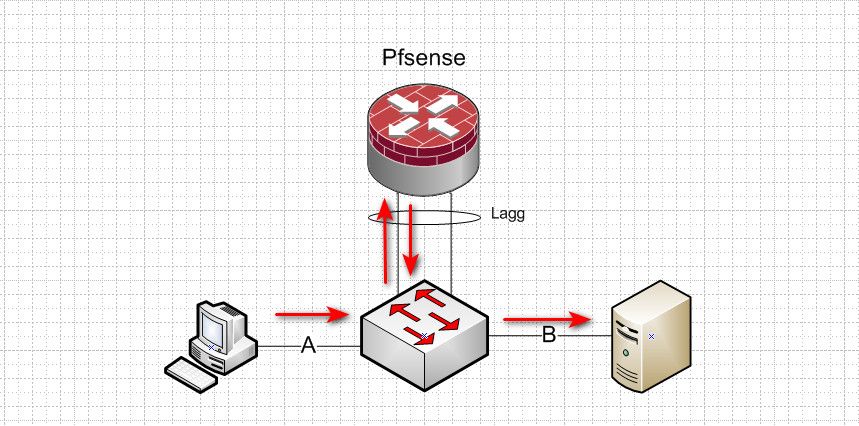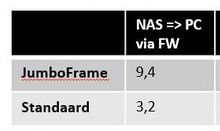Trouble with configuring Jumbo frames :(
-
@louis2 and can your PC even write at 850MBps? your (6.8Gbps), let alone your nas at 1100MBps.
did you do this test over your lagg - where all you know your traffic is hairpinning when your nas sends via route, and clearly not when on the same network.
From your traces your offloading on your pc, and not on pfsense. That is why you see large size on your pc side and 9000 on your pfsense side. Where was the test from PC to nas with 1500 and jumbo?
Do a sniff where your pc traffic comes into pfsense. Your sure not going to see 62k size.
I would take the lagg out of the equation and use 2 different physical wires for your 2 networks for your 1500 vs jumbo tests.
For difference in 6.8 to 9.3 to make a difference your devices would need to be able sustain read/write at those speeds to and from their disks.. At 9.3 your talking about sustained read/write over 1100MBps
-
John I will make a small drawing tomorrow. However My test setup is quite simple:
My PC and NAS are equiped with NVME SSD's
The NIC has two (fiber) ports.
port-1 is connected via the normal route vlan => pfsense => NAS
or in more detail
PC => 10G-switch
=> 10G lagg to pfSense
=> back to 10G-switch
=> to the NAS on the 10G-switch
=> 10G lagg to pfSense
=> back to 10G switch
=> 10G-switch to pCPort-2 is connected to a small 10G-switch
small 10G switch to 10G-switch
to the NAS
back to the small 10G switch
back to the PC
All on the same GreenZone VlanFor the test I did enable NIC port-1 for the tests via pfsense
and for the other test I enable port-2For the 1500 test I changed the 9000 mtu in the following way
pfSense- trunk on pfSense still 9000
- mtu for greenzone 9000 => 1500
NAS - trunk still 9000 (I think I did test with both 9000 and 1500)
- greenzone mtu back to 1500
PC - NIC MTU to 1514 (default value)
-
To be shure
- one capture was made using wireshark on the PC and
- in parallel I used the capture on pfsense to capture the traffic towards the NAS
-

Here the setup and results from my jumbo frame test.
The differences between jumbo and standard are significant bigger than before. I do not know why.
The behavoir when sending data from PC to NAS is by far not as smooth and stable as from NAS to PC. I tried what the best MTU settings is for PC and NAS (on trunk level!!_ I can not change that on pfSense.
Especially the PC profit strongly from a bit bigger MTU than 9000.
The application frame at the NAS and pfSense where 1500 and 9000 all the time, I can not control that on the PC.
As before I do not understand every thing especially as related to the behavoir of the Windows11 PC.
-
you are still on a lagg - you have no idea if that hairpinns or not..
take the lag out of the equation on both your nas and your pfsense. Are disks involved in this test? Take them out - use just iperf.

Using different uplinks for each network (a or b) prevents hairpin.
When you lagg you don't actually know what physical interface is being used.. You could end up with this
 f
fLags are great when you have lots of different devices talking to lots of other devices, and you want redundancy if one of the connections fail. Or more bandwidth in the total pipe that multiple clients talking to multiple other devices can share. But when you throw a bunch of vlans on a lag, and you have intervlan traffic that routes over the same lag, you are not going to be sure it doesn't hairpin. Which depending might not matter so much if say your lagg connection was 10ge and your devices connections were only 1ge.. But when you want to make sure that your not sharing the same physical connection for both directions of the traffic for optimal speed, lagg is not the way to go because you have no actual control over which path traffic will take.
Same goes for just 1 single connection, ie a trunk port that has multiple vlans on it - and you have intervlan traffic - your going to hairpin.
-
John I really really do not understand your hairpin / lagg issue !!!
In case the pc and the nas are on a different vlan, the traffic will pass pfSense.
Add that implies an upstream and a downstream both through the lagg. And IMHO it is not so interesting which physical path from the lagg they take.
So you are correct the uplink and the down stream could take the same physical path. But each physical path is 10G-up and 10G down. And since stream-1 is almost 100% up and the other stream is almost 100% down they are not eating each others bandwidth away. So in the worst case scenario the lagg capacity equals the capacity of one 10G-connection.
The NAS connection is 10G just as all other connections. So the maximum traffic the NAS can generate is 10bit.
Being the sum to all other vlans. And if that are other vlans they will all pass pfSense. So what !!??In case the traffic stays on the same vlan, the traffic will not pass pfSense at all, so not passing the the lagg at all.
For info at this moment I use L2/L3/L4 hash algorithm at the pfSense side. At the switch site (SX3008F) I use source and destination IP). I could reserve one path for the NAS vlan and the other path for all other vlans'but if that would be an improvement ... I doubt.
So what what is the problem !!!!!! ??????
Louis
-
@louis2 These are the only 2 machines talking to each other at the same time? Then it isn't a problem, your acks are going to go on the same wire as well now.. So you would never be able to see full throughput. be it that small.
Your talking about a optimization of jumbo, but then are not caring about your overall bandwidth being reduced.
What if you have machines C and D talking to each other on a completely different vlans - but they share the same wire now. Or could be.
If your happy with your setup.. Have at it.
All of that aside - you still haven't shown that your disks can read/write at the extra throughput jumbo could bring.. If the disks can not write/read even bandwidth X (standard 1500).. Does it make any sense to complex up the network with jumbo to gain that extra speed jumbo could provide?
There is no freaking way jumbo gives you this sort of boost

You have something else going on there.. If you are only seeing 3.2 on 1500, and 9.4 on jumbo.